A methodology for simultaneous fluorogenic derivatization and boronate affinity enrichment of 3-nitrotyrosine-containing peptides
- PMID: 21855526
- PMCID: PMC3195362
- DOI: 10.1016/j.ab.2011.07.024
A methodology for simultaneous fluorogenic derivatization and boronate affinity enrichment of 3-nitrotyrosine-containing peptides
Abstract
We synthesized and characterized a new tagging reagent, (3R,4S)-1-(4-(aminomethyl)phenylsulfonyl)pyrrolidine-3,4-diol (APPD), for the selective fluorogenic derivatization of 3-nitrotyrosine (3-NT) residues in peptides (after reduction to 3-aminotyrosine) and affinity enrichment. The synthetic 3-NT-containing peptide, FSAY(3-NO(2))LER, was employed as a model for method validation. Furthermore, this derivatization protocol was successfully tested for analysis of 3-NT-containing proteins exposed to peroxynitrite in the total protein lysate of cultured C2C12 cells. The quantitation of 3-NT content in samples was achieved through either fluorescence spectrometry or boronate affinity chromatography with detection by specific fluorescence (excitation and emission wavelengths of 360 and 510 nm, respectively); the respective limits of detection were 95 and 68 nM (19 and 13 pmol total amount) of 3-NT. Importantly, the derivatized peptides show a strong retention on a synthetic boronate affinity column, containing sulfonamide-phenylboronic acid, under mild chromatographic conditions, affording a route to separate the derivatized peptides from large amounts (milligrams) of nonderivatized peptides and to enrich them for fluorescent detection and mass spectrometry (MS) identification. Tandem MS analysis identified chemical structures of peptide 3-NT fluorescent derivatives and revealed that the fluorescent derivatives undergo efficient backbone fragmentations, permitting sequence-specific identification of protein nitration at low concentrations of 3-NT in complex protein mixtures.
Copyright © 2011 Elsevier Inc. All rights reserved.
Figures


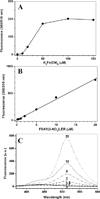


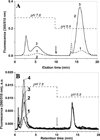



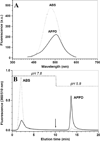
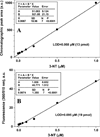
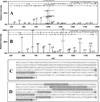
References
-
- Turko IV, Murad F. Protein nitration in cardiovascular diseases. Pharmacol. Rev. 2002;54:619–634. - PubMed
-
- Reynolds MR, Berry RW, Binder L. Nitration in neurodegeneration: deciphering the “Hows” “nYs”. Biochemistry. 2007;46:7325–7336. - PubMed
-
- Ischiropoulos H. Biological selectivity and functional aspects of protein tyrosine nitration. Biochem. Biophys. Res. Commun. 2002;305:776–783. - PubMed
Publication types
MeSH terms
Substances
Grants and funding
LinkOut - more resources
Full Text Sources
Research Materials

